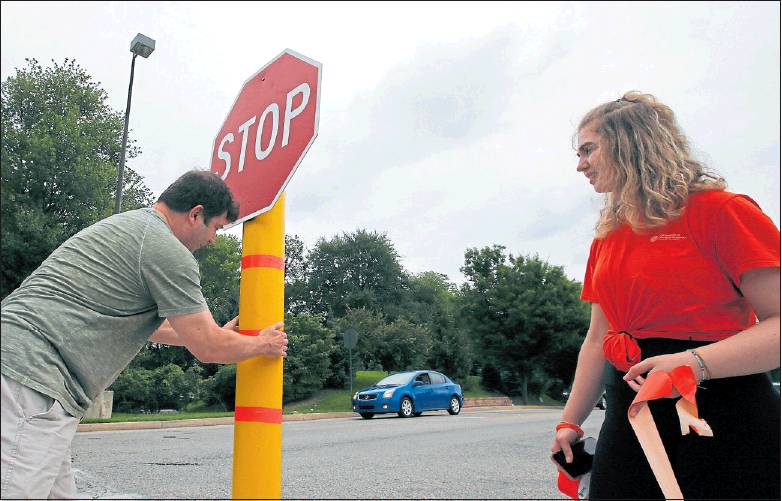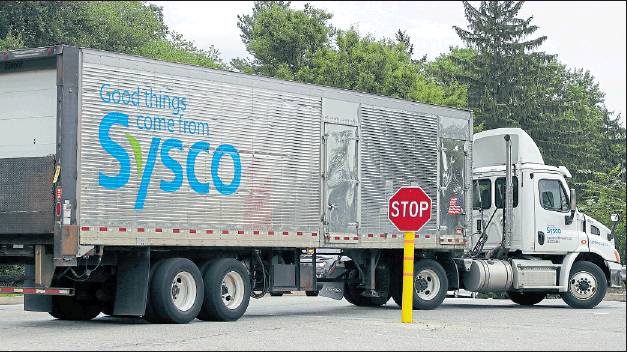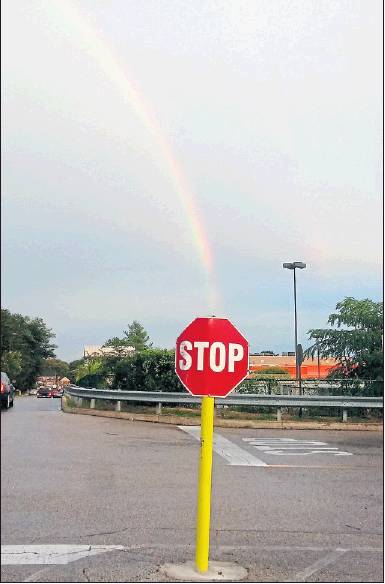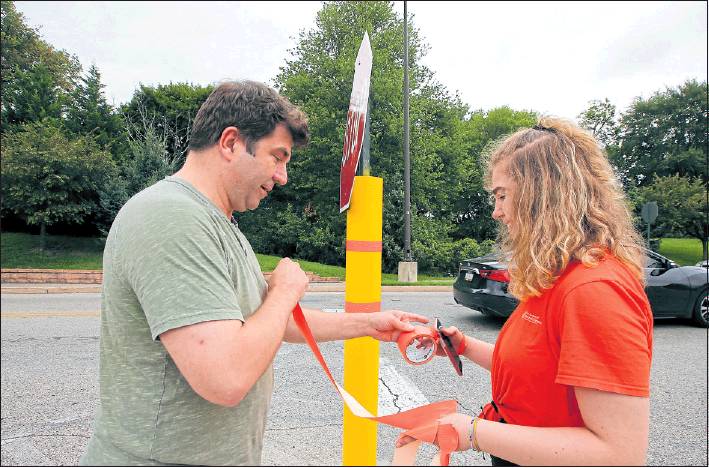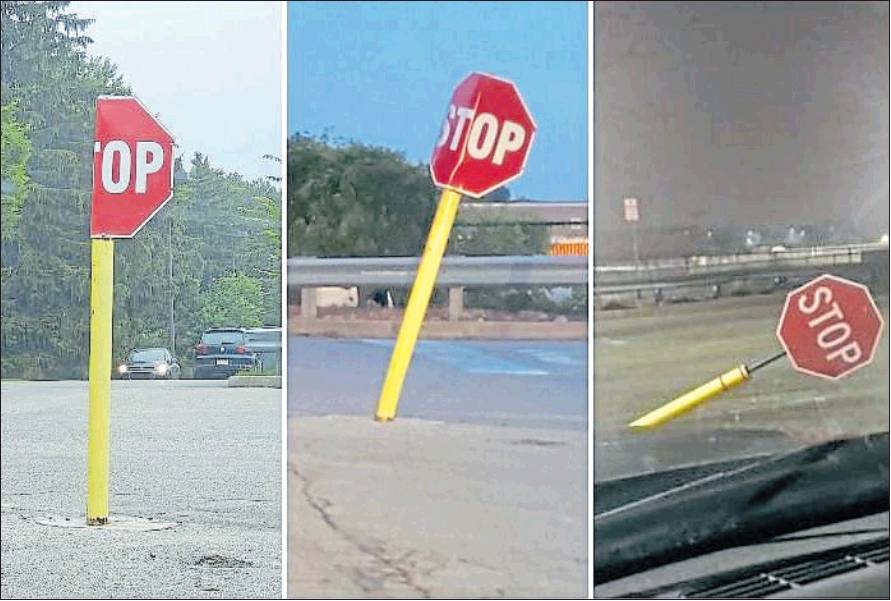UNSTOPPABLE
Located in a Cheltenham shopping center, the sign has been knocked down for years. Now, though, a love for “Stoppy” has sprung up and it’s being embraced as a symbol of resiliency.
By Stephanie Farr STAFF WRITER
On a busy road in the far reaches of a Cheltenham shopping center, positioned precariously close to the loading dock of a Target store, stands a lone stop sign named Stoppy.
Well, on good days it’s standing. But most days are not good days for Stoppy, who routinely gets struck, bent, and toppled by passing big rigs and cars. Estimates for how many blows Stoppy has suffered over the last decade range from 50 to 70.
“If you recall wondering just how many hits to the face Rocky’s gonna take before the music starts … we’re in that neighborhood,” Cheltenham resident James Montgomery, 46, said.
Yet each time, Stoppy reemerges, like a phoenix from the ashes, ready to suffer the slings and arrows of outrageous fortune again in the name of safety.
For years, some residents of Cheltenham Township, which includes neighborhoods like Wyncote and Elkins Park, have quietly followed Stoppy’s saga as they drove through the Greenleaf at Cheltenham shopping center in Wyncote. Stoppy sits on Shoppers Lane (a popular thoroughfare between Route 309 and Washington Lane).
But around the time quarantine hit last year, people began publicly documenting the stop sign’s trials and tribulations on the Elkins Park Happenings! neighborhood Facebook page.
“I wasn’t the first to post about it, but the more people started to be angered by things the more it appealed to me — let’s just make Stoppy our mascot because it’s so silly,” said Susan Chelder Schuman, 61, of Elkins Park. “Let’s root for this poor, defenseless, little stop sign.”
Since February 2020, there have been at least 36 posts about Stoppy, each of which typically gets hundreds of interactions.
Not only did the group give Stoppy a name, members gave it a theme song, “Tubthumping” by Chumbawamba (“I get knocked down, but I get up again”); created a Facebook service page for it; and dressed it up in a scarf, face mask, and a neck tie. Montgomery gave Stoppy a tie in November when it marked a full year without being replaced (but not without damage).
“I drove over, and in the middle of midday traffic, I whipped up a double Windsor on my favorite inanimate object,” Montgomery said of the tie, which he bought in 1997 for a blind date to the Trans-Siberian Orchestra.
Stoppy’s been romantically linked to a shopping cart, a port-a-potty, and a nearby yield sign and it’s been compared to Rocky, Mr. Bill, and even the Dread Pirate Roberts from The Princess Bride (because of its many iterations).
Some call Stoppy “a traffic control device professional,” others call him “a hero,” “a martyr, “an icon,” and “a sign for our times.”
“Stoppy is an anthropomorphized, multigenerational, frequently abused, and universally beloved stop sign stationed by the loading dock of a Target that has become a hyper-local social media phenomenon,” said Tiffany Gaal, 30, of Elkins Park. “As soon as I saw my first post about Stoppy, I knew I was committed to loving that stop sign and loving other people loving that stop sign.”
Folklorist Fariha Khan, associate director of Asian American Studies at the University of Pennsylvania who serves on the board of the American Folklore Society, said it’s “not lost on anyone” that Stoppy took on particular significance to people during COVID-19 and a time of extreme isolation.
“They’re connected around, not the stop sign, but the process of the shared art. There’s the verbal lore, there’s a material aspect to it when they’re dressing the stop sign, there’s a visual aspect, seeing it resurrected,” Khan said. “This shared art is creating meaning for the individuals … and it creates a particular sense of identity and belonging that’s highlighted during a pandemic.”
Kurt Gray, associate professor of psychology and neuroscience at the University of North Carolina-Chapel Hill, said people often anthropomorphize — or assign human characteristics to objects and animals — when lonely or trying to understand something the only way they know how, through their own human experience. People are particularly prone to anthropomorphizing things they feel have been victimized, he said.
“You see something like Stoppy that gets constantly abused, it sticks out because it’s uncommon and then as it keeps on getting harmed … we can’t help but think of it as a suffering creature,” Gray said. “Nothing makes the human mind try to make sense of things more than bad things because we want bad things not to happen.”
Nobody’s quite sure when Stoppy first appeared but most agree it started taking hits around the time the Target replaced the movie theater at the shopping complex in 2009.
The store’s loading dock is very close to Stoppy, and the prevailing theory among members of the Facebook group is that most hits to Stoppy come from truck drivers leaving or entering the dock who either can’t see it or have difficulty maneuvering the tight turns.
Al Sergio, code administrator for Cheltenham Township, said Stoppy has gone down “at least once a year in the last seven years, easy, maybe more.”
The section of Shoppers Lane Stoppy is on is private property and Sergio said repair and replacement of the sign is handled by Paramount Realty Services, the property management company for the shopping center. Requests for comment to Paramount were not returned.
When Stoppy fell earlier this month, the township put up a temporary sign and asked Paramount to replace the main one. Under the misapprehension that the temporary sign was theirs, Paramount workers used a portion of it to create a new “conglomerate sign,” Sergio said.
“They repurposed our stop sign and will reimburse the township for replacement,” he said. “This time around we did ask the management company to come up with some type of design to eliminate this getting knocked over constantly.”
(Previous suggestions offered up in the Elkins Park Facebook group for protecting Stoppy include: jersey barriers, flashing lights, a hi-vis safety vest; a 15-foot high steel gantry; and an antimatter shield.)
Resident Don Milley, 50, and his daughter, Cate, now 17, are credited with naming Stoppy. Ever since Cate was a little girl who put a y on the end of everything (doggy, orangey, Stoppy), they’ve been following Stoppy’s “ups and downs with great interest.”
Cate lives with amplified musculoskeletal pain syndrome, which causes her brain to misinterpret regular nerve signals for pain, and she has chronic migraines.
“Cate has been hospitalized 16 times in the last three years, so Stoppy’s troubles and how he’s gotten beat up actually resonated with our family. We empathize greatly with him,” Milley said. “As silly as it is to anthropomorphize him, it’s just a very visible symbol of getting knocked and getting back up again that’s resonated both with our family and, it seems, to some degree, the community.”
Laurie Greene, associate professor of anthropology at Stockton University, said Stoppy may mean so much to so many people because now, more than ever, they can relate to it.
“This stop sign has gone through a lot of trials and tribulations … and in this pandemic, we feel like that. We’re helpless and innocent and just doing our jobs and getting run over right and left,” she said. “It’s become a symbol of our current experiences that allows us to express our frustrations in a humorous way.”
Anthropomorphizing Stoppy may have evolutionary benefits, too, not just because it’s created social bonds among community members but also because it hones our social skills for empathy, Greene said.
“If we can relate to a stop sign and show compassion for it, there’s a greater chance we can relate to our fellow human beings,” she said. sfarr@inquirer.com
215-854-4225
FarFarrAway
“ Stoppy is an anthropomorphized, multi-generational, frequently abused, and universally beloved stop sign stationed by the loading dock of a Target that has become a hyper-local social media phenomenon.
Tiffany Gaal, of Elkins Park
